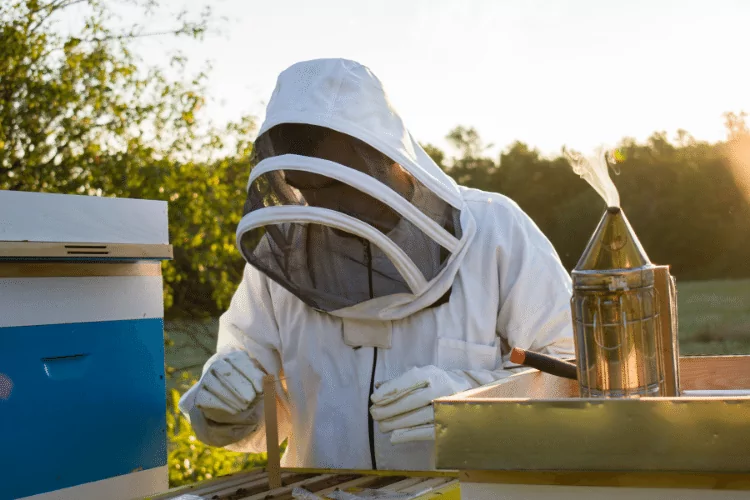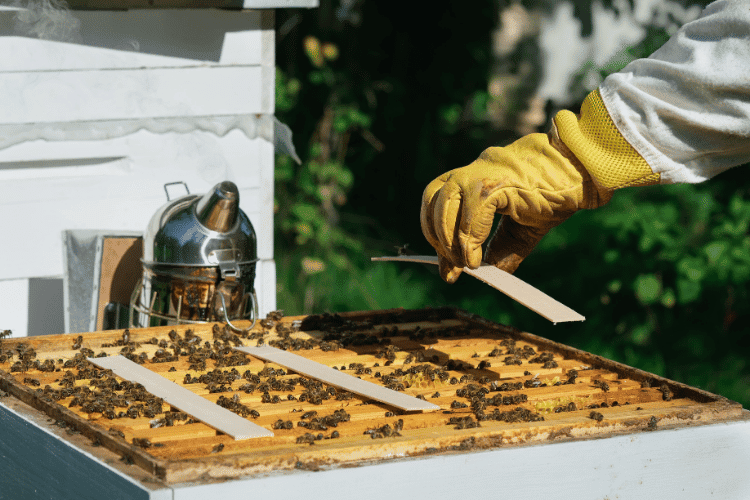Mite infestations pose a grave risk to your honey bee hive. These parasites can come from various ways. Imagine this, a colony already collapsing from being overrun by mites while bees from other hives rob the weaker hive’s honey.
Somewhere along the way, a Varroa mite hitched a ride and found its way to greener pastures. Now, you’re likely browsing through multiple treatment options. Two of the most widespread options are Apivar and Formic Pro.
Both are excellent choices for ridding your hive of blood-sucking parasites but differ in function, use, and effect. For instance, Formic Pro uses organic compounds rather than Apivar’s synthetic make.
Stick around to learn more about the differences, pros, and cons of Apivar vs. Formic Pro.
Apivar vs. Formic Pro: Comparisons
Apivar and Formic Pro are highly effective choices for treatment methods. Getting rid of Varroa mites is critical to keep your hive healthy and well-functioning.
When choosing a treatment, each option differs based on its active ingredient, application, duration of use, treatment period, and honey flow usage. Here’s how.
Active Ingredients
Check out the active ingredients and their benefits for each mite treatment application.
Formic Pro

Formic Pro’s active ingredient is formic acid. The organic acid infiltrates the mites’ brood cap and spreads around mite reproductive sites.
Fun fact: formic acid is naturally emitted from ants when warding off potential predators. Birds have also caught on to the pest control benefits of the chemical. They place ants within their feathers to rid them of mites.
Apivar
Apivar’s active ingredient is Amitraz. Unlike formic acid, Amitraz is a synthetic substance. Safety-wise, it’s around 7000 times less noxious to bees than mites. The ingredient produces seizure-like effects in the Varroa mites.
Now, Amitraz works by binding with mite receptors to gradually get rid of them. Now, the downside is that bees can have similar receptors. In turn, the pesticide treatment can harm your bees when left long after its recommended period.
Treatment Period
Each treatment is active depending on seasonal changes. You can use Formic Pro during the Spring and Autumn months. Apivar is more flexible and applicable all year round.
On top of seasonal applications, you’ll also want to consider temperature usage. The formic acid option requires temperatures between 50 and 85 degrees F.
The Amitraz treatment doesn’t have a specified temperature range, making it a more versatile mite treatment.
Honey Flow Usage
You can’t use some treatments when honey flow is being harvested. The good news is that Formic Pro doesn’t have this restriction thanks to its organic and biodegradable construction.
On the other hand, you can’t collect honey when using Apivar’s synthetic chemical treatment. You’ll have to wait at least two weeks after using the pesticide to harvest honey.
Application
Formic Pro comes in gel strips. Beekeepers use it to treat Tracheal and Varroa mite infestations. You’ll need to place the strips in the brood box or center of the colony for even dispersion of the organic chemical.
The strips’ outer layer releases the active ingredient’s vapors. When in use, place extra supers with honeyless frames. In addition, keep the bees well-nourished before treatment.
Similar to Formic Pro, Apivar also uses strips. You’ll need to put two strips in the brood chamber for maximum efficacy. You can hang the strips between the frames using a toothpick or the pop-up triangular tag that comes with the package to prop them upwards.
Duration of Use
When it comes to how long the treatment can last, each option differs. With Apivar, you can place the strips for up to 42 days. Avoid exceeding 56 days.
Meanwhile, Formic Pro offers two treatment plans. One can last for 14 days and the other 20 days. In turn, Formic Pro wins this round as a fast-acting treatment. During the 14 days, you can keep two strips in the brood box. The other option allows you to place one strip every ten days.
Why You Need to Get Rid of Varroa Mites
Whether you use Apivar or Formic Pro treatments, removing a Varroa mite infestation is critical for your hive’s health. These mites feast on your adult bees’ hemolymph or blood. They also consume your drone population’s brood production.
Consequently, the infestation can weaken your bees, spread diseases, and hit your hive’s population. As a result, your colony’s bees won’t be able to produce as much honey, leading to a hive collapse.
Varroa mites are a vital pest issue in the U.S. and Europe. They’re responsible for over 95 to 100% of wild honey bee deaths after three to four years of infestation.

How to Identify Varroa Mites
Varroa mites are typically oval in shape and reddish brown. The darker, larger ones are usually the female.
Even though they can feed on adult honey bees’ blood, they usually prefer to suck their nutrition from developing larvae and pupae in the brood chambers.
Fortunately, you can use multiple methods to detect Varroa mites, such as sugar shaking, alcohol washing, and drone uncapping.
Pros and Cons of Apivar
Check out some of the pros and cons of using Apivar.
Pros
- Highly effective
- Applicable all-year-round
- Easy to use
Cons
- Mites can develop resistance against active ingredient
- Synthetic ingredients can pose negative effects on bees
Pros and Cons of Formic Pro
Here are the advantages and disadvantages of sticking with the naturally-derived Formic Pro product.
Pros
- Uses organic ingredients
- Short usage period
- Biodegradable
Cons
- Not as effective as a synthetic treatment
- Temperature-dependent
Apivar vs. Formic Pro: Which is the Winner?
Overall, Formic Pro is better if you’re searching for a natural solution. Meanwhile, Apivar promises better efficacy because of its more potent active ingredient.
Nevertheless, Formic Pro works faster, since the most you’ll need to keep the strips is 20 days. In contrast, Apivar strips need to be kept for around six weeks. Plus, if kept for longer, they can harm your bee’s health.
In terms of use, Apivar is easier since it doesn’t require a specific temperature or season to work like Formic Pro.
- Does Bleach Kill Bees? - April 23, 2024
- How Do I Get Rid of Ants Without Harming Bees? - April 16, 2024
- Do Bug Zappers Kill Bees? Completely Explained - April 9, 2024
